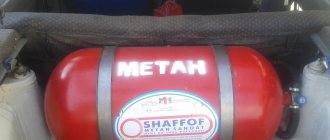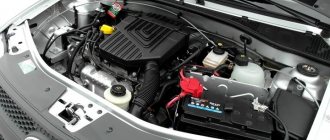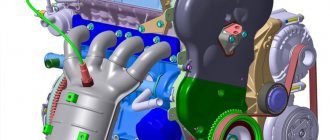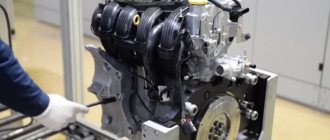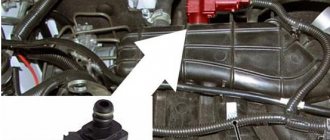July 15, 2016 Lada.Online 93 490 9
At the beginning of 2016, AVTOVAZ showed a new 1.8-liter engine with a power of 122 hp. with index VAZ-21179. At first this engine was installed on the Lada XRAY, and then it appeared under the hood of the Lada Vesta sedan. Let's consider its characteristics, features and reviews from the owners of this power unit.
Technical characteristics of the VAZ 21179 engine
Comparison table of Lada Vesta and XRAY engines:
| Engine model | VAZ 21129 | HR16DE/H4M | VAZ 21179 |
| Symbol | 1.6 l, 16 cl | 1.8 l, 16 cl | |
| Type | Petrol, 4-cylinder, in-line | ||
| Working volume, l (cm3) | 1,6 (1596) | 1,6 (1596) | 1,8 (1774) |
| Cylinder diameter, mm | 82 | 78 | 82 |
| Piston stroke, mm | 75,6 | 83,6 | 84 |
| Compression ratio | 10,5 | 10,7 | 10,3 |
| Number of camshafts | 2 | ||
| Number of valves per cylinder | 4 | ||
| Timing drive type | Toothed belt | Chain | Toothed belt |
| When the timing belt breaks | Valve bending (until 08/15/18) | — | Valve bend |
| Rated net power, kW/hp. (at crankshaft rotation speed, min-1) | 75/106 (5500) | 81/110 (5800) | 90/122 (6000) |
| Maximum net torque, Nm (at crankshaft speed, min-1) | 148/4200 | 150/4000 | 170/3750 |
| Minimum crankshaft rotation speed at idle, min-1 | 840 | 675-725 | 840 |
| Weight, kg | 92,5 | n.d. | 109,7 |
| Ignition system | Electronic, contactless, microprocessor controlled | ||
| Cylinder operating order | 1-3-4-2 | ||
| Supply system | Multiport fuel injection | ||
| Fuel | Unleaded gasoline with octane number 95* | ||
| Availability of neutralizer | Eat | ||
| Toxicity standards | Euro 5 | ||
| Oil consumption depending on fuel consumed, % | 0,3 | 0,3 | |
| Oil volume in the lubrication system of an engine with a cast (light-alloy) sump (manual transmission), l | 4,1 | 4,7 | 4,1 |
| Engine oil quality class according to API* | SL, SM or SN | ||
| Engine oil viscosity grade according to SAE* | see motor oil | see motor oil | see motor oil |
| Resource, km | 200 000 | ||
Belt life:
- Timing belt - 180 thousand km.
- Drive belt for auxiliary units - 90 thousand km.
Causes of problems and solutions
In the very first Vesta and X-Ray models that came off the assembly line in 2016, motor 21179 has been in use for less than two years. At this stage, only two problems have been identified that are unique to this modification:
- increased oil consumption - insufficient quality of valves made in China, replacement with original Mahle parts is necessary;
- wear of the crankshaft and liners - poor lubrication due to manufacturer defects; replacement of the original yokes with versions of previous engines with a small groove and main bearing liners with a 180-degree groove is required.
Fuel rail
Other malfunctions are similar to 16 valve internal combustion engines of previous generations.
Peculiarities
The first AVTOVAZ engine with a volume of 1.8 liters is built on the basis of the previous VAZ-21127/21129 engine (volume of 1.6 liters). The working volume was increased by increasing the piston stroke from 75.6 to 84.0 mm. For the first time, a VAZ (Variable Valve Timing) system, a phase shifter or “phaser” began to be used on a VAZ engine. It changes the position at which the intake valves begin to open depending on engine speed and load. This ensures maximum air filling of the engine and allows for a more even distribution of torque depending on the speed.
When assembling the engine the following are used:
- Lightweight valves are from Mahle.
- Pump from GMB (increased performance and service life).
- GMB oil pump (high performance).
- Automatic toothed belt tensioner from INA.
- Lightweight connecting rod and piston group - manufactured by Federal Mogul.
- The fuel rail is from Continental.
- Catcollector from the Russian company Ecoalliance.
- Camshafts made in South Korea by Toyota Tsusho.
What has been improved:
- Cylinder block with additional lubrication channels
- The crankshaft has an increased crank radius and other counterweights.
- The diameters of the crankshaft connecting rod journals were reduced from 47.8 to 43 mm (reducing mechanical losses).
- Oil channels with drilling from neck to neck (reduced cost, less chips left).
- A graphite coating is applied to the piston skirt; the shape of the skirt is adjusted to increase the contact patch.
- The rings are the same, only the oil scraper rings are chrome plated.
- Reducing the length of the connecting rod from 133 to 128 mm.
- Main bearings with an oil distribution groove of variable cross-section are installed (to reduce oil consumption).
- Camshafts are hollow inside (lighter).
- Instead of a soft one, a metal head gasket is used (cylinder deformation has dropped to 25 microns).
- and etc.
Maintenance and repair of the 1.8-liter engine is less convenient than that of previous VAZ 1.6-liter power units. The designers did not provide a simple mechanism for fixing the crankshaft when setting the marks. The absence of marks on the pulleys, as well as fixing the camshafts, requires special equipment. And to replace the timing belt on a VAZ 21179, you will need to disassemble almost half the engine. More details about this in the video:
Another review of the VAZ 21179 engine:
Also see the process of assembling and testing the VAZ 21179 engine.
Reliability, weaknesses, maintainability
Reliability
The issue of reliability of the VAZ-21179 has always caused controversy among car owners. It was not possible to reach a common opinion.
The manufacturer has made several attempts to increase the reliability of the internal combustion engine. Unfortunately, they did not lead to the expected result. As noted, the main problem with this engine was high oil consumption. The main ways to solve this problem were chosen:
- changing the valve timing control calibration;
- contacting valve suppliers to improve the quality of supplied products;
- changes in the manufacturing technology of valve stem seals;
- replacing 5W30 oil with a more viscous one;
- changing the design of the oil deflector.
A huge amount of work has been done in these areas, but has yielded virtually no results. Car enthusiasts write about this in their comments on forums. So, Xotab_555 o. And such reviews are not isolated.
At the same time, it is noted that some engines lasted 300-350 thousand km without breakdowns or deviations in oil consumption. But, judging by the reviews, this applies to those engines that have undergone a major overhaul with the replacement of the piston group and boring of the cylinders.
The general conclusion is not comforting - the reliability of the VAZ-21179 engine is extremely low.
Weak spots
There are not so many of them, but they are significant. Increased oil consumption has already been mentioned. Another problem that often occurs in the lubrication system is the oil pump pressure relief valve jamming in the open position.
The main reason for the phenomenon is contamination of the working surface with combustion products and the use of contaminated oil.
Oil leaks through seals. Eliminated by replacing seals or gaskets. Sometimes it's enough just to tighten them a little more.
The occurrence of knocking noises when the engine is not warmed up. In most cases, the “authors” are hydraulic compensators. This is not fatal, but in this case it would not be superfluous to have the engine diagnosed at a specialized service station - there are many reasons for the appearance of knocking noises.
The electrics of the unit also cause a lot of complaints. Particularly annoying is the regular appearance of the “Check Engine” icon on the dashboard. Often, immediate computer diagnostics of the engine in this case does not detect any deviations in the operation of the engine systems.
Low quality of parts supplied for assembly by importers, especially from China.
Other malfunctions that sometimes occur in the unit are not critical.
Reviews about engine 21179
The plant positions the new VAZ-21179 power unit as a modern engine with good dynamic performance. The new engine is in many ways similar to 21129, which leaves owners with a mostly positive impression. The near future will show what the power unit of the VAZ-21179 will turn out to be in practice.
Leave your feedback about the VAZ-21179 engine, and also take part in the survey. Let us remind you that an AVTOVAZ specialist spoke about the new VAZ engines and the features of their torque in one of the issues of “Okay Mechanics”.
Keywords: Lada Vesta engine | lada xray engine
1 0 0 0 1 0
Share on social networks:
Maintenance
The actual life of the internal combustion engine is still unknown due to the short service life of the first cars that rolled off the assembly line in 2016. However, to increase it, engine 21179 should be serviced according to the regulations below:
- 10,000 km means changing the filter/oil;
- twice as long, the alternator belt runs 30,000 km;
- after 45,000 km, change hoses/fittings and antifreeze;
- spark plugs and batteries are enough for 60,000 km;
- About 180,000 the original timing belt passes.
For 2022, the internal combustion engine device is considered the most advanced in the AvtoVAZ manufacturer’s line. In practice, his project had been considered since 2006, but was constantly postponed until the technical, economic and market situation in the Russian Federation finally developed favorably. That is, AvtoVAZ in this project prioritized the power output of the engine, and not economical fuel consumption, as was usually the case before.
Hidden design reserves
The capabilities of the 179th engine are not exhausted by today's performance. If there is need and funding, the following forcing options are possible:
- Installation of the 2nd “phaser”. The main advantage of this solution is the improvement of environmental parameters; the increase in power is not very significant. Moreover, the option is not easy and quite expensive.
- An increase in power can be achieved by lengthening the exhaust channels of the catalytic collector (the so-called “pants”). With short pipes in front of the “barrel”, turbulence of the working medium is formed, caused by pressure surges as a result of the exhaust. With the removal of the neutralizer from the BC, the nature of the movement of gases approaches laminar, power losses are reduced, but at the same time the emission purification deteriorates. However, with a compromise solution, this option is quite acceptable, and its implementation is associated only with the rearrangement of the power unit. And deteriorated environmental performance can be compensated by the VVT system.
- Thanks to the easily changeable design of the cam shafts, you can experiment with debugging all timing parameters.
- Finally, we can return to a two-mode intake system: long path at low speeds and short path at high speeds. As mentioned above, a compromise option has now been implemented - the average length of the intake tract.
XRAY and Vesta cars with a 1.8 engine have been in use for less than a year, so no systemic deficiencies have yet been noticed in these engines. As they say, the flight is normal. In any case, AvtoVAZ design services are able to quickly eliminate possible shortcomings so that the 21179 engine does not disappoint the expectations of car enthusiasts.
Cylinder head
The cylinder head is made from aluminum, just like the base engine. But there is a significant difference - in the cylinder head of the VAZ-21179 there is a system of additional oil channels to the phase shifter control valve, originating from an additional oil supply point from the block between the first two cylinders. In this case, the valve acts as a solenoid that regulates the flow of lubricant into the chambers of the VVT system. The lubrication system has been improved - in the intake camshaft support, which had to be expanded for this purpose, there are two oil intake channels and one outlet. These channels are connected through an electrovalve in a certain way to the chambers of the phase shifter, which rotates under their influence. Possible oil leakage through the camshaft seals is resolved by installing drain holes in the front supports.
photo of VAZ-21179 block head
Real fuel consumption
According to AvtoVAZ: Fuel consumption depends on the vehicle and transmission.
But we immediately note that in some operating modes the 21179 engine turned out to be much more economical than all 1.6 liter engines. What is the real fuel consumption on the West? Real fuel consumption : After talking with car owners, it becomes clear that fuel consumption is not quite as economical as the factory tells us:
Cylinder block
The material used for the cylinder block of the 21179 engine is traditional - cast iron. But the filling is not traditional, it is new: - in the cooling system - additional channels of the original cross-section between the second and third cylinders, to increase the efficiency of the system in order to increase the service life of the piston rings, which had high wear due to overheating of the inter-cylinder walls; - in the lubrication system - an additional oil channel, communicating with the main one, between the first two cylinders, for supplying oil in the cylinder head to the automatic phase distribution regulator, phase shifter;
photo of VAZ-21179 cylinder block
Water pump
The VAZ-21179 pump is produced by the same Korean company GMB. The water pump is equipped with high-quality bearings, high-quality seals and also has enhanced characteristics, since by increasing the engine power, it is inevitably necessary to improve its cooling system.
photo water pump VAZ-21179
Site materials - https://vestaxray.ru
History of origin
Motor 21179 was already in the minds of the engineer much earlier than you can imagine. Even at the end of the USSR, developers began to think about the Lada C project and its power units. Even then, engineers “knew” this motor by its features and power characteristics. But the difficult economic situation of that time and the collapse of the USSR forced the engineers to completely forget the Lada-Ts project.
And now, after a long time, when Boo Anderson comes to the post of general manager of AvtoVAZ, the project is raised and developed again.
The main task was to create an engine with good low-end torque, which AvtoVAZ lacked for a confident, comfortable ride. “Tractor” 8-cl engines have long since become obsolete, but the new 16-cl engines had a more “sporty” character. The situation was corrected by the then 21127 engine, now 21129, which is installed on Vesta, Xray, and other AvtoVAZ models. Due to the intake receiver with variable geometry installed on it, the torque from the bottom began much earlier, unlike the Prioromotor (21126), and its shelf was much further, right up to the cutoff. But with the start of production of a sedan with a larger mass - the Vesta, and the Xray hatchback - the need for low-end engines reappeared.
Four Well-Known Facts
The service life of the timing chain always exceeds the service life of the engine. This is the first fact, but a condition must be met: the oil change must be timely. In general, the circuit fails gradually, and this is accompanied by symptoms:
- Audible sounds (chirping) at idle speed;
- When the “problem area” passes, a phase shift may be observed.
The last defect is detected using computer diagnostics.
From the appearance of any symptom to the complete rupture of the chain, a certain time passes. And in general, a “defective circuit” can work for a long time. This was another, fourth fact.


